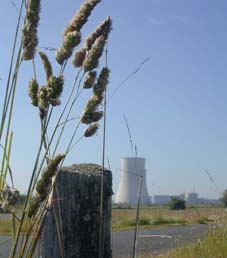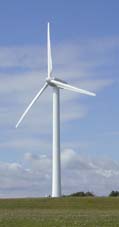|
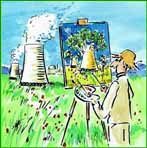
|
EFN -
NEWS
Newsletter of
EFN
Environmentalists
For Nuclear Energy
11th
August 2004
|
This document is archived on
the internet and can be consulted at the following address:
http://www.ecolo.org/archives/archives-nuc-en/
New e-mails for writing to
EFN: scroll to the bottom of this page
Causes
of the industrial accident at Mihama in Japan

by Bruno Comby
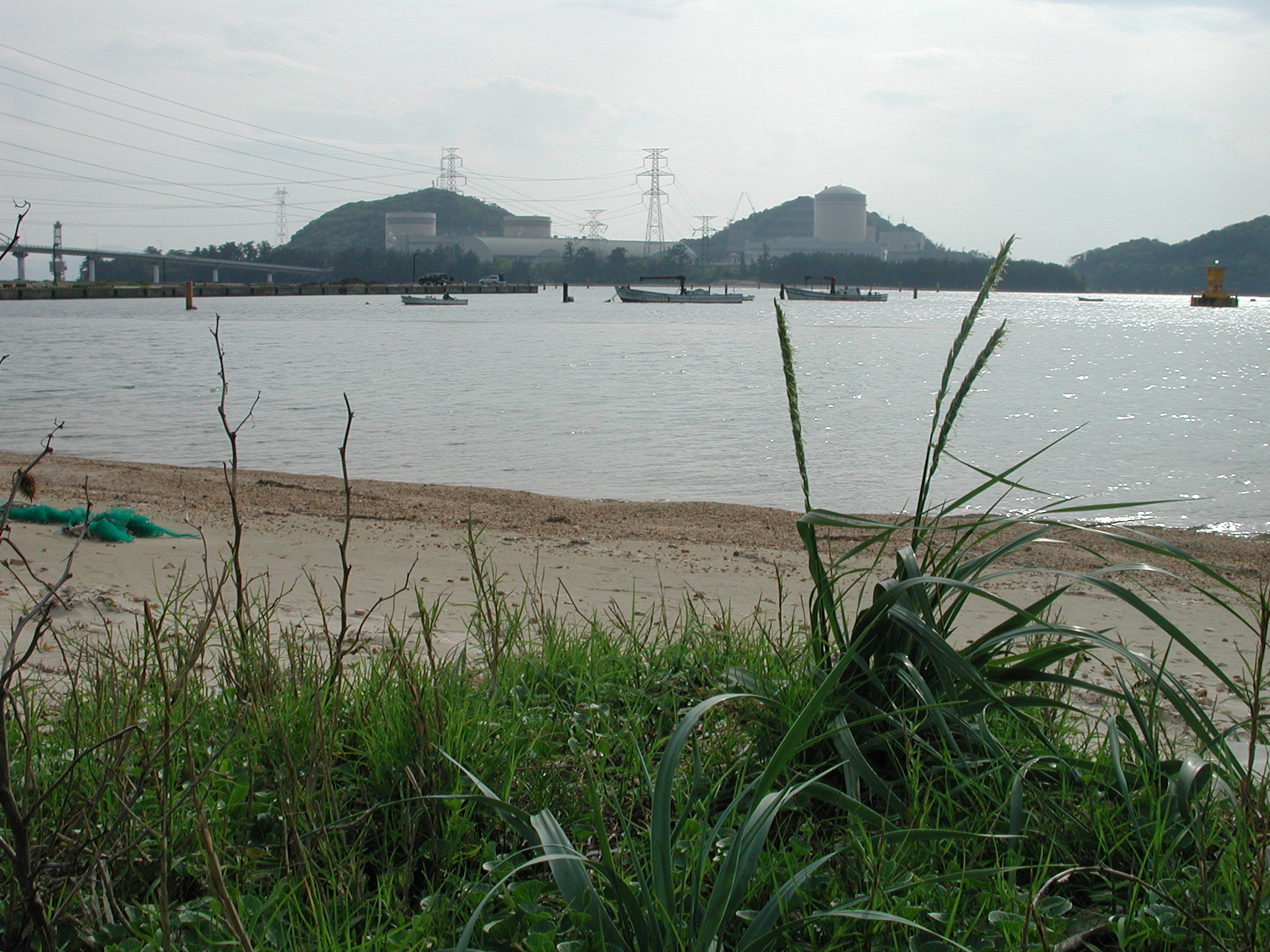 Photo
of the Mihama nuclear power plant seen from the nearby beach. The
accident took place in the turbine hall of reactor number 3 which is
the one on the right of this photo.
Photo
of the Mihama nuclear power plant seen from the nearby beach. The
accident took place in the turbine hall of reactor number 3 which is
the one on the right of this photo.
© Photo EFN - www.ecolo.org /
Bruno Comby (April 2001)
Dear readers, dear friends,
Following the accident which occurred two days ago
at the Japanese nuclear power station at Mihama, please find below
some information about this event.
The cause of that accident was the suddden rupture
of a pipe carrying pressurized water in the secondary circuit of the
power station, after it had passed through the turbine and heat
exchanger and before it returned to the steam generator (see
photos
and the schematic of the
circuit below). In an instant, the pipe
broke, and an enormous burst of steam was released into the turbine
hall.
Eleven persons who were in the turbine hall at
that moment were seriously burned (scalded). Four of them died the
very day of the accident. At least two of the other seven are in a
critical state and their prognosis is not favorable.
The rupture occurred in a straight part of a black
steel tube 56 centimeters (22 inches) in diameter
carrying pressurized water.
When the reactor was at full power, that steam
would have been at a temperature of 195°C, under a pressure of
12.7 atmospheres (about 180 psi); we have been told that, at the
moment of the accident, the temperature was 140°C and the
pressure 9 atmospheres, but that information is yet to be
confirmed.
When the power station was built, the wall of the
tube was 10 mm thick (0.4 inch), and it was supposed to remain at
least 4.7 mm thick to stay safe; but, as one can see from the photo
below, it was almost entirely eroded and down to 1.4 to 1.5 mm thick
in a large area around the rupture zone. There was a great deal of
corrosion. This reflects a major fault, either at the stage of
engineering design, where the phenomenon of corrosion was
under-estimated or neglected (similar pipes in more recent nuclear
power plants are now in stainless steel, not black steel); or in the
inspection routine. Periodic inspections, correctly carried out using
ultra-sound instruments currently in wide use, would have revealed
the weakened state of this tube.
The Mihama-3 reactor, a Mitsubishi pressurized
water reactor of 826/780 MW(e), diverged in January 1976 and was
connected to the grid on 19th February 1976. It has thus operated for
28 years and should have been the subject of at least two major
inspections. Major inspections on nuclear power plants are usually
performed every 10 years. These inspections are particularly
detailed. How could they not have detected this defect? According to
today's news broadcast on the Japanese television, but yet to be
confirmed, this pipe had not been verified even once since the
reactor was put into operation. It seems then that there have
been one or several instances of severe incompetence.
During a press conference held at Mihama, 350 km
west of Tokyo, Koji Ebisuzaki, director of quality control,
said "We are responsible" Haruo Nakano, spokeman for KEPCO,
the utility which owns and operates the plant, declared "We made
visual inspections but never used ultra-sound." Ultra-sound
inspections on this tube were not obligatory, but thaere is no other
way to detect internal corrosion of such a tube. KEPCO had recently
put off an in-depth technical evaluation of the very tube which
failed. The inspection of this tube had been planned and should have
been performed several months earlier, but KEPCO had decided to
postpone this verification until the next inspection.
EFN reminds the world and insists upon the
point that maintenance and safety in nuclear power stations are and
must remain absolute priorities.
We note however that even though several mistakes
were committed at different levels: the pipe was in black steel that
corrodes easily, the corrosion was not checked, the Japanese safety
authorities new that this pipe needed to be changed (several had
already corroded and had been replaced by stainless steel pipes in
other Japanese nuclear power plants), and above that the inspection
which was planned (too late) was postponed, the basic principles of
nuclear safety nevertheless still played their role effectively to
prevent from a larger accident: the multi-level and redundant safety
systems installed at different levels shut the reactor down
automatically and immediately without any other incident, despite the
extremely rare character of the event and the gravity of the
situation.
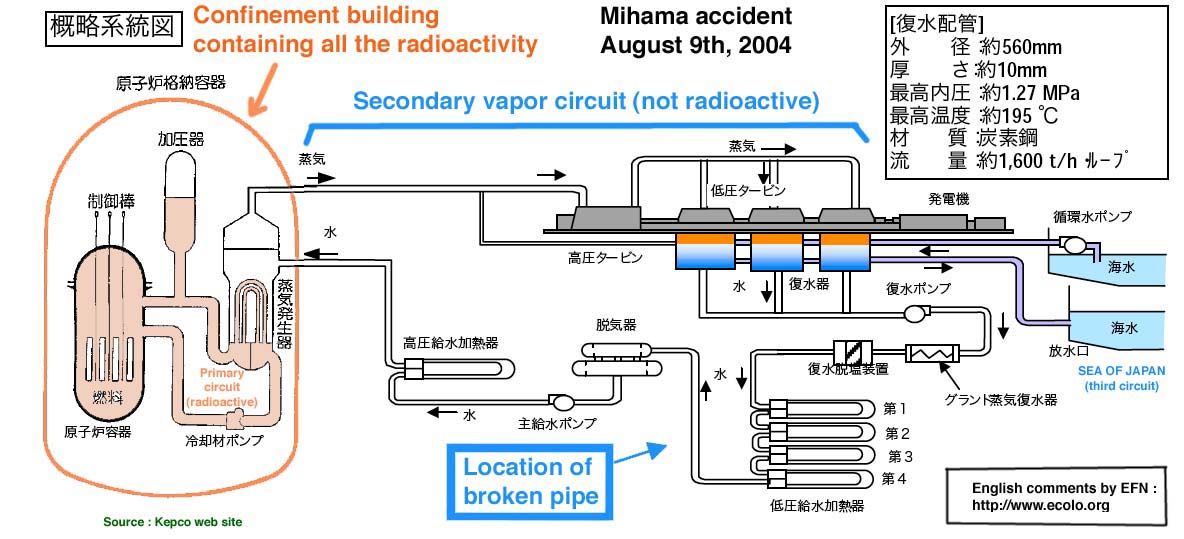
Yesteday's news bulletin mentioned steam at 260 or
270°C. That would be the temperature at the exit of the steam
generator, before passing through the turbine and condenser; but it
was not there that the rupture occurred. At the site of the rupture,
after the turbine and condenser, the temperature would be lower but
still high enough to inflict serious burns on the unfortunate men
working nearby in the turbine hall.
The nuclear reactor shut down spontaneously at the
moment of the accident, but it is not clear at this moment whether it
was the rupture of the tube which caused the emergency shutdown of
the reactor (which is the most likely scenario), or whether some
other event led to the automatic shut down of the reactor, causing an
overpressure itself causing the corrosion-weakened tube to
fail.
We wish to repeat that absolutely no radioactivity
was released into the environment. The accident was not nuclear but
industrial - it could have happened in any power station whether
heated by nuclear energy or by burning fossil fuel.
With four victims (to date), this is a tragic
event. In fact, it is the worst accident to have occurred in a
nuclear power station since the Chernobyl accident of 1986. But we
must view things in perspective: recent news items have shown us once
again that natural gas is a killer, causing many fatal incidents and
killing many more persons each year; not to speak of the thousands
who die every year in coal mine accidents without getting the same
attention from the media.
The flow in the secondary circuit of the power
station, is about 1600 tonnes of water per hour, about 27 tonnes per
minute, or, if you like, nearly a tonne every two seconds. And this
under a pressure of about ten atmospheres. When the pipe ruptures
like this, the pressure is reduced and the water (140°C)
transforms into steam, is projected until it fills the entire
machinery hall. Our brief calculation suggests that it would take
only a couple of minutes to fill a hall of dimensions 100m x 50m x
20m, unless the leaking pipe could be isolated and the flow of steam
stopped.
The ruptured circuit was isolated, and the steam
projections stopped indeed after some time (how much? we don't know).
According to information published by the Japanese media (asahi.com),
there were 220 subcontractors (which is a lot) working inside the
plant (how many of them in the turbine hall when the accident
occurred? we don't know). The subcontractors were preparing a planned
inspection which was about to start a few days later.
The 11 workers who were scalded seem to be those
who were nearest to the pipe when it broke. Some of them had severe
body burns because they received bursts of steam directly on their
bodies, and others badly burned their lungs by breathing the hot
steam as it spread throughout the turbine hall. Four have already
died and seven of them are now struggling for life in the Fukui
prefecture hospital. One of them is severely burnt on 80% of body
surface, and will certainly not survive, and several others are in
critical condition. Luckily, some workers managed to escape the
turbine hall safely (how many? we don't know).
Hot pressurized water and steam are
dangerous. In bygone days, industrial and
domestic boiler and hot-water heater accidents were frequent, often
involving equipment which was badly adjusted, badly maintained and
without adequate safety systems. Many victims were scalded (burnt by
steam) and many died of their burns. Sometimes it was faulty
equipment, but often it was imprudence. For example, in steamboats
navigating the Mississippi River a century ago, it was not uncommon
to tie down the safety valves, especially in a boat race, or just to
let the pressure rise higher, forcing the boat at a higher speed. In
one case, on the Mississipi river in 1865, a steam explosion is said
to have killed 1,547 people, many of whom were prisoners being
trasferred, when the steam boiler powering the boat suddenly
exploded. Many were scalded and died from the explosion itself, and
others drowned. Nor were industrial boiler explosions rare. Since
then, safety standards have been imposed and progressively tightened.
In the United States, there is a long standing National Board of
Boiler and Pressure Vessel Inspectors whose standards and rules are
accepted world-wide. Chemical engineers are particularly alert to
these questions. Nevertheless, steam burns and boiler explosions
still kill frequently. Numerous references are obtained for example
by searching for "boiler explosion" on the internet.
In any event, as the Mihama accident reminds us,
there is no energy without risk, and hot pressurized water (whether
produced in a nuclear reactor or not) is dangerous and should be
handled with precaution. Accidents are always possible, and we must
be extremely vigilant and prudent to create and strengthen a culture
of safety and meticulously respect the rules. Although rarer than
before, industrial accidents due to corrosion of pipes and steam
explosions still occur, but they are hardly mentioned in the media,
when they occur in places other than nuclear power plants.
What would be the impact of an accident as serious
as Mihama, if it had occurred in any plant but nuclear? Perhaps an
article in the local or regional paper, an item on the evening TV
news, but it would certainly not receive the honors of notice in the
international press as Mihama does these days.
On the one hand, we should learn from this sort of
experience and do everything to avoid the recurrence of accidents
like Mihama. In case such an accident does occur, we must be able
limit the damages by prevention.
On the other hand, we must emphasize the
NON-NUCLEAR nature of this accident, which might have occurred in any
other factory or in a power plant fired by gas or coal or oil. It was
not a NUCLEAR accident. It was an INDUSTRIAL accident.
Greenpeace and other ecological movements around
the world have already begun in their own shameful way to take
advantage of this unfortunate accident, and to demand once again that
the world abandon nuclear energy, in Japan and elsewhere. They are
not impressed by the fact that THE ACCIDENT AT MIHAMA WAS NOT A
NUCLEAR ACCIDENT. Recent gas explosions have had many more victims
than Mihama, but we don't hear these associations calling to "stop
gas" or for a "gas-free world" comparable to the "stop nuclear" or
"nuclear-free world" shoutings which re-appeared today in reaction to
this unfortunate INDUSTRIAL (NOT NUCLEAR) accident. Explosions are
rather a speciality of gas, you know; they cause more frequent and
bigger accidents, with many more victims than yesterday's accident in
Japan. Is there any consistency in their behavior?
EFN extends its most sincere condolance to the
families of the victims.
Sincerely yours,
Bruno Comby
President of EFN
Environmentalists For Nuclear Energy (civilian only, properly used,
and with the greatest of precautions)
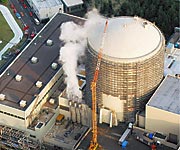 On
this photo taken on August 9th, 2004, one can see the steam rising
from the turbine building of reactor number 3 at the Mihama Nuclear
Power Plant in Fukui Prefecture. That steam comes from the inside of
the turbine hall,.which is the rectangular building on the left hand
side of the photo. The reactor itself containing the nuclear fuel is
located inside the circular-shaped concrete confinement in the center
of the photo. The nuclear reactor, the confinement building, and the
primary circuit were not affected at all by the accident. Mihama was
not a nuclear accident. The nuclear part of the installation was
unaffected. No radiation leaked and the reactor itself always
remained safe and under control.
On
this photo taken on August 9th, 2004, one can see the steam rising
from the turbine building of reactor number 3 at the Mihama Nuclear
Power Plant in Fukui Prefecture. That steam comes from the inside of
the turbine hall,.which is the rectangular building on the left hand
side of the photo. The reactor itself containing the nuclear fuel is
located inside the circular-shaped concrete confinement in the center
of the photo. The nuclear reactor, the confinement building, and the
primary circuit were not affected at all by the accident. Mihama was
not a nuclear accident. The nuclear part of the installation was
unaffected. No radiation leaked and the reactor itself always
remained safe and under control.
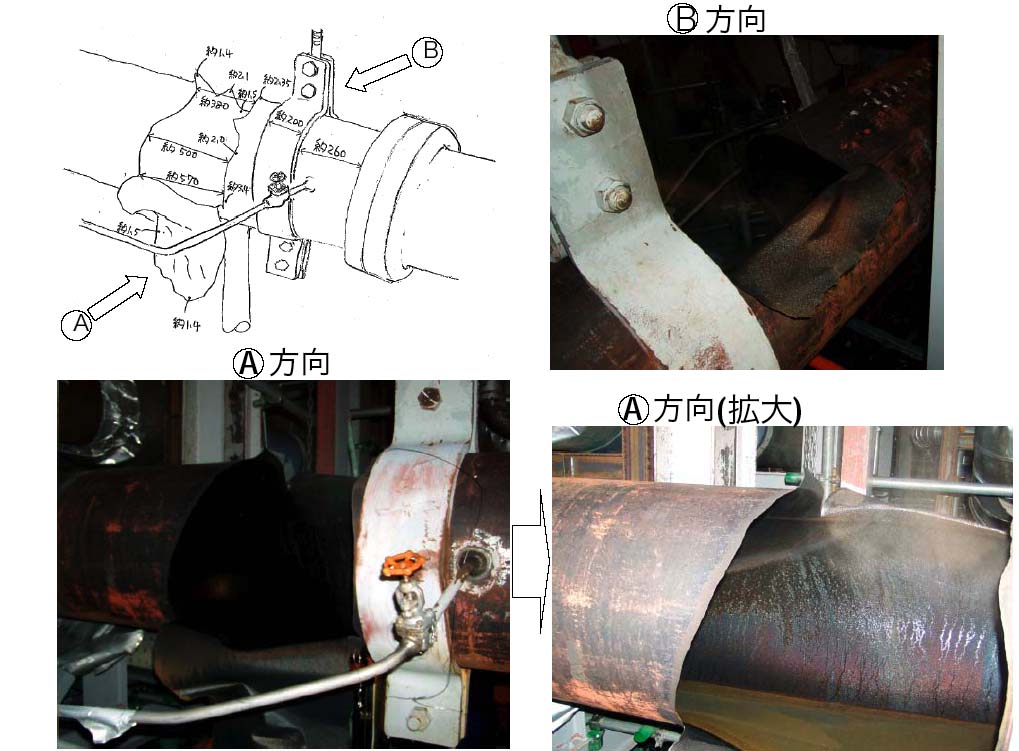
Photos of the scene of the
accident and ruptured pipe : source KEPCO - Kansai Electric Power
Corporation (August 10th, 2004)
Bruno Comby, EFN founder and
president (http://www.ecolo.org
), is the author of 10 books published in 15 languages on ecology and
energy, including the bestseller "Environmentalists
For Nuclear Energy"
(published by TNR
Editions). He is a
graduate of the Ecole Polytechnique in France, and holds a
postgraduate qualification as nuclear physicist from the Superior
National University of Advanced Technology in Paris
(ENSTA).
Copyright notice : you are
authorized (and encouraged) to distribute, translate and/or publish
the text above freely, in paper or electronic form, and to send it to
the media for publication, with the authorization to be published,
under the condition that : 1/ it is republished or transmitted as is,
without any modification (other than minor editing) 2/ you send a
copy of the published article(s) to: EFN[at]ecolo.org 3/
translation(s) be sent to EFN for reviewal before publication, such
translation(s) may be posted on EFN's web site and/or to EFN's
mailing lists. If substantial modifications (other than minor
editing) are required such as adding comments or making significant
changes to the text, please contact EFN.
New
e-mails for writing to EFN
To write to EFN, please use the following e-mail
addresses, and your messages will be sent directly to the adequate
correspondent:
Contact for North America :
nuc-us[at]ecolo.org (Environmentalists For Nuclear Energy)
Contact in English language :
nuc-en[at]ecolo.org (Environmentalists For Nuclear Energy)
Contact in French language :
nuc-fr[at]ecolo.org (Association des Ecologistes Pour le
Nucléaire)
Contact in Japanese language :
nuc-jp[at]ecolo.org
To write to Bruno Comby (President of EFN) :
New e-mail : bruno[at]ecolo.org. Update your files. From now
one, please do not use this old address any more : [email protected],
this address is to be deleted from all your files. It will be dropped
in a few days.
To write to Berol Robinson (President of EFN-USA :
berol[at]ecolo.org
 Berol
is the President the American association of Environmentalists For
Nuclear (EFN-USA) http://www.ecolo.org/base/baseus.htm
; this association was incorporated in the State of Delaware. EFN-USA
is distinct from EFN-EUROPE, and operates as an organization with
similar activities and for the same purpose (informing the public on
energy) but in the United States. EFN-USA was recently approved by
the IRS as a tax-exempt 501(c)(3) not-for-profit corporation,
authorizing tax-deduction of your donations (click on the American
flag on the home page http://www.ecolo.org and then on "subscribe" or
"donation" in the menu. You can make a donation by check, credit card
(paypal) or bank transfer, as indicated. EFN-EUROPE is also a
tax-deductible organization in France.
Berol
is the President the American association of Environmentalists For
Nuclear (EFN-USA) http://www.ecolo.org/base/baseus.htm
; this association was incorporated in the State of Delaware. EFN-USA
is distinct from EFN-EUROPE, and operates as an organization with
similar activities and for the same purpose (informing the public on
energy) but in the United States. EFN-USA was recently approved by
the IRS as a tax-exempt 501(c)(3) not-for-profit corporation,
authorizing tax-deduction of your donations (click on the American
flag on the home page http://www.ecolo.org and then on "subscribe" or
"donation" in the menu. You can make a donation by check, credit card
(paypal) or bank transfer, as indicated. EFN-EUROPE is also a
tax-deductible organization in France.
Please receive our ecological salutations and best
wishes for the end of the summer season !


http://www.ecolo.org
EFN - For complete and
straightforward information on energy and the
environment
To subscribe (or unsubscribe) to EFN's mailing list, go to EFN's
web site : http://www.ecolo.org
and click on "mailing list".
You may, with their approval, freely subscribe to the mailing list
all those among your friends who would like to be informed about
energy, the environment, and EFN's activities. To do this, just type
their e-mail address above, and click the "Subscribe" button (with
their approval).
To subscribe to our mailing list, the only condition is to share
our point of view and to type in your e-mail in the box above. You
will then be informed automatically of EFN's activities. This
subscription is entirely GRATIS. EFN is a not-for-profit
organization. It does not place any commercial advertisements on it's
web site, and does not sell it's mailing lists to anybody. To help
the EFN continue its activities, inform the public, and maintain this
FREE service, you can subscribe
or make
a donation to the association. Your donations are tax-deductible
in France. For subscriptions and donations intended for EFN-USA,
click
here (for our American readers and US citizens, donations in US$,
EFN-USA is a 501(c)(3) tax-exempt not-for-profit corporation). For
donations in Japanese Yens (for our Japanese readers), click
here.
©
EFN, all rights reserved - Unless
specifically mentioned otherwise, reproduction, use or distribution
of these information, texts or images, without EFN's prior written
approval, is forbidden


 Photo
of the Mihama nuclear power plant seen from the nearby beach. The
accident took place in the turbine hall of reactor number 3 which is
the one on the right of this photo.
Photo
of the Mihama nuclear power plant seen from the nearby beach. The
accident took place in the turbine hall of reactor number 3 which is
the one on the right of this photo.
 On
this photo taken on August 9th, 2004, one can see the steam rising
from the turbine building of reactor number 3 at the Mihama Nuclear
Power Plant in Fukui Prefecture. That steam comes from the inside of
the turbine hall,.which is the rectangular building on the left hand
side of the photo. The reactor itself containing the nuclear fuel is
located inside the circular-shaped concrete confinement in the center
of the photo. The nuclear reactor, the confinement building, and the
primary circuit were not affected at all by the accident. Mihama was
not a nuclear accident. The nuclear part of the installation was
unaffected. No radiation leaked and the reactor itself always
remained safe and under control.
On
this photo taken on August 9th, 2004, one can see the steam rising
from the turbine building of reactor number 3 at the Mihama Nuclear
Power Plant in Fukui Prefecture. That steam comes from the inside of
the turbine hall,.which is the rectangular building on the left hand
side of the photo. The reactor itself containing the nuclear fuel is
located inside the circular-shaped concrete confinement in the center
of the photo. The nuclear reactor, the confinement building, and the
primary circuit were not affected at all by the accident. Mihama was
not a nuclear accident. The nuclear part of the installation was
unaffected. No radiation leaked and the reactor itself always
remained safe and under control.
 Berol
is the President the American association of Environmentalists For
Nuclear (EFN-USA)
Berol
is the President the American association of Environmentalists For
Nuclear (EFN-USA) 
